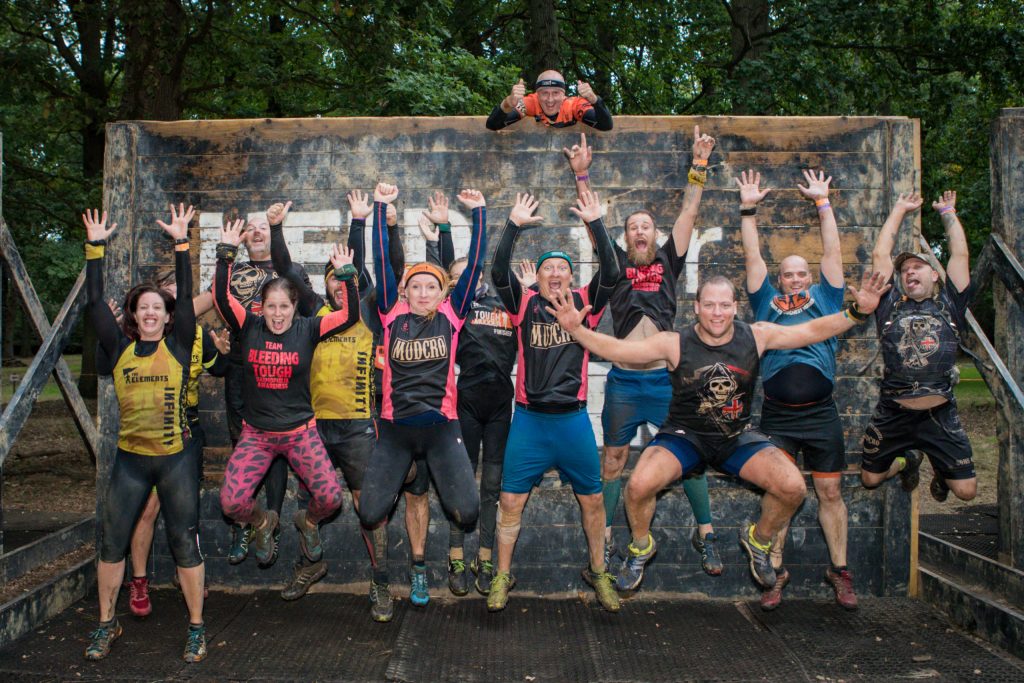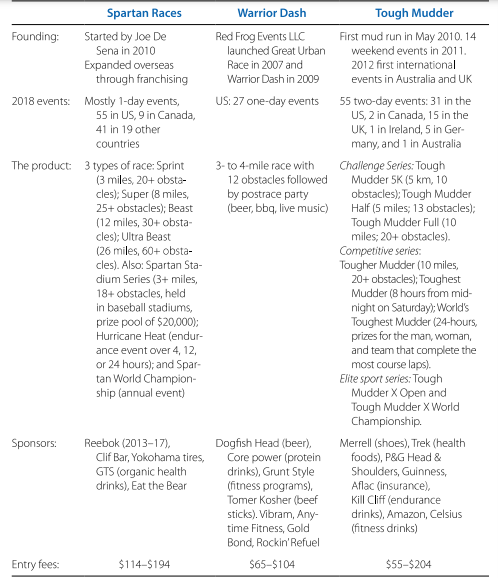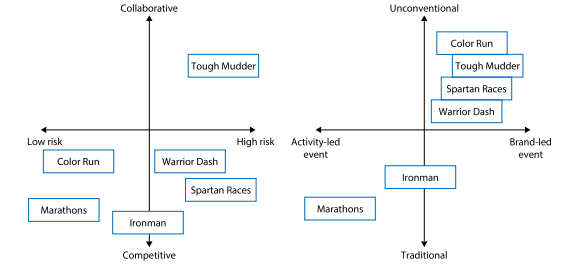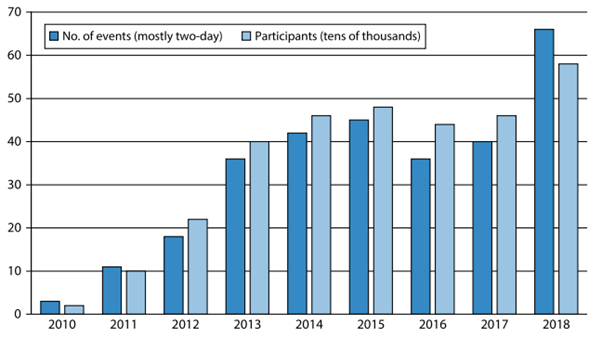Executive summary
The study is mainly focused on strategic management and decision making in the regard of case study related to Tough Mudder and an effective process of a Mud run. The present-day persistent sports activities are tracked via numerous sports activities, and those are marathons in 1896, orienteering in 1930, and triathlon in 1920 alongside “novelty activities”, “OCRs (Obstacle route races)”, and journey races. OCRS is disclosed as a valid recreation that is growing on the premise of going for walks and sports activities off “non-traditional” in 2015 and 2016. Some of the examples are “Great bull run”, “Color run”, “Tomato Royale”, paddling, biking, and activities of the USA going for walks. After that, to identify the competitive growth of the company, Porter’s five forces are discussed in an appropriate way, and for analyzing better opportunities in business, SWOT has been performed appropriately.
1. Introduction
The decision-making process and relevant activities are dependent on the major five activities, and these are threat, opportunity, risk, strengths, and countervailing. Strategic management is fully based on the decision-making activities for managing better services and business growth for an organization with a great competitive advantage. The study is mainly focused on strategic management and decision making on the basis of case study analysis for Tough Mudder Inc for building leadership in Mud runs. Besides, Tough Mudder hosted approximately 200 events with 2 million participants, and 200 people were employed with revenue of $100 million in 2018. Various challenges are included in this case, and that is filled with ice in a dumpster, and that is “Arctic Enema”, and “Augustus Gloop”, which indicates climbing a vertical tube by using cascading of water, and “Electroshock therapy”.
A small analysis of the case study
Tough Mudder is a series of premier adventure challenges in the world, and that is considered more than an event to manage the way of thinking in an individual. Throughout the challenge of Tough Mudder, a true sense can be accomplished, and a great discovery and time of camaraderie participants are experienced these days indicate a very rare form of this activity. Modern endurance sports are traced through several sports activities, and these are marathons in 1896, orienteering in 1930, and triathlon in 1920, along with “novelty events”, “OCRs (Obstacle course races)”, and adventure races. Some of the examples are “Great bull run”, “Color run”, “Tomato Royale”, paddling, biking, and events of cross country running (Tough Mudder, 2021).
After that, all the strategic options and supporting options of these activities of Tough Mudder can be optimized through the proper identification through the case study analysis.
2. On the basis of the case study analysis and current internal as well as external environment, critically evaluate the strategic options and support of these options for Tough Mudder
Other endurance sports and psychology mud runs are considered as a complex thing, and all the participants are perceived mental as well as physical limits that combine great identifications of “nourishing camaraderie” and “warrior role models”. The newspaper “New York Times’ ‘ describes the “Walter Mitty Weekend warrior complex”, and that includes mud-deist, most agro participants from wall street, and most avid. In 2018, a list of 881 Mud Run guided obstacle races, a series of active races, and adventure races (Tough Mudder, 2021). Various non-profit organizations arranged different charity events, and in 2013, an event was held in US OCRs with 3.4 million participants and paid approximately $290.1 million (Inc fact, 2021). All the internal as well as external capabilities are identified in this case study analysis, and most of the events had some difficulties, as well as some of them, which are really crucial to maintain better opportunities in this regard. OCRS is disclosed as a legitimate sport that is developing on the basis of running sports off “non-traditional” in 2015 and 2016.
SWOT analysis:
SWOT analysis can help to identify better activities in case of market operation and better management of opportunities, weaknesses, threats, and strengths. These are discussed as follows:
Strengths:
It defines the area in which the organization is in command or is good at commanding and provides key functions. Besides, as depicted by Fetchko et al. (2018), it can be images, skills, “market leadership”, various resources, and well-established relationships with suppliers as well as buyers, along with other competitive advantages that can meet the needs of the market through giving companies a comparative advantage.
Weakness:
Tough Mudder weakness refers to a situation where a company’s existing resources and valuable skills are considered inadequate or weak on the comparison of other organizations within the market. Apart from that, this indicates an aspect of an organization that is inefficient and all needs are managed to improve for adapting to current market trends. After that, as opined by Dickson (2017), these aspects negatively impact the organization’s overall performance by weakening it compared to its competitors. These are factors that organizations lack and are inadequate compared to organizations operating at the same level in the same market. Lack of resources, skills, abilities, or limitations can significantly impact the effective performance of a company. As an example, equipment, management skills, financial resources, poor branding, and marketing skills can be weak points for Tough Mudder.
Opportunities:
Tough Mudder Opportunities are a business asset and driving force. It is the best situation and appropriate time to manage the environment and be able to help the organization achieve their targets and goals in a significant way (Wright, 2019). Added to this, business assets are a factor that helps to better contribute to market development and business growth within the best organizations. This indicates a particular position of the external environment, and that is helpful to maintain the organization for managing its leverage along with the strengths, and overcome its weaknesses as well as neutralize threats that always belong within the environment.
Threats:
Threats are crucial factors that must be identified and prevented within an organization to carry out the best activities. Besides, unfavorable environmental conditions can create difficulties for an organization to achieve success and goals. Additionally, these are situations that result from changes in the immediate or distant environments that prevent an organization from claiming its existence and superiority in the face of intensifying competition and are harmful to the organization (Kuokkanen, 2019). As a result, all effective environmental factors can be considered as threats to Tough Mudder, and that can affect its business effectiveness and efficiency.
Figure 1: Obstacle course events
(Source: From case study)
The total budget of Tough Mudder entry fees are approximately $55-$204, and most of them are sponsored by Amazon, shoe company Merrell, Health foods like Trek, and insurance companies like Aflac (Inc fact, 2021). Added to this, the product is divided into three categories, and these are challenge series, competitive series, and Elite sports series. All the events of Tough Mudder are held in different countries like Australia, Germany, Canada, the US, and the UK. From the case study analysis, the first mud run happened in 2010 in the UK and Australia, and due to this, the name Tough Mudder is continuously growing with the best activities.
Figure 2: Endurance Sport market
(Source: From case study)
From the experience of different mud runs and their aspects, various factors are included within this. These are fun, exhaustion, fear, and camaraderie and these all are in the case of products for Tough Mudder. Moreover, by applying collaborative dimensions, Tough Mudder can manage team management and leadership quality for business and is able to control the complete course in an adequate way. One of the major challenges is managing Tough as “formidable”, and that indicates the toughest event in the world (Dickson, 2017). On the other hand, for managing corporate participation, Tough Mudder can offer the best of customization with corporate packages, and that can be included catering, private tent, and other services.
3. Critical analysis of competitive and growth strategies of Tough Mudder
In order to manage the Competitive analysis of the Tough Mudder, Porter’s five forces can be the best option to identify the competitors with the best option and various activities in this process. The major five factors in this process are competitive rivalry, threats of substitutes, customers’ bargaining power, suppliers’ bargaining power, and threats of new entrants.
The threat of new entrants (High):
The organization can be a new company or a company planning to diversify. After that, different issues and barriers can be included in both various legislation and industry. Reputation and the size of companies are managed actively within the market and also have an impact on the development of Tough Mudder. In addition, costs associated with entering into the market, accessing raw materials and devices, barriers in cultural activities, and standards of technical services can play a viable role in determining new market participants (Scahill, 2020).
The threat of substitute (Medium):
The high risk of substitution reduces profitability by limiting the profit of the industry, and all the pricing caps are set within for fear of being replaced by applying another product in the market. After that, it also has an impact on the potential growth of the industry, such as reducing profitability a great deal. As a result, as opined by Černikovaitė and Karazijienė (2019), different companies have used the same technology within the market, and all these are replaced by “by-products” from several companies with high profitable sectors, and that are relatively more superior in quality as well as price.
Bargaining power of suppliers (High):
Powerful providers have extra strength to seize tremendous costs for themselves via way of disturbing excessive expenses even as restricting the pleasant and the amount of the product or offerings or via way of shifting the price at the player of the industry (Wei and Davis-Ngatai, 2017). Many circumstances imposed via the way of the providers commonly consist of the boom in charge even as compromising the pleasant and quantity.
Bargaining power of buyers (Medium):
Customers of Tough Mudder are considered with strong activities and during bargaining, especially when this specific industry price is sensitive. After that, customers can encourage suppliers to reduce prices further. Customers with strong power of bargaining can be more reliable as well as significant to manage profitability, and that is helpful for operating by analyzing the market conditions (Porter and Porter, 2017). Thus, these are less favorable on the basis of managing suppliers with quality, price, or service.
Competitive rivalry (Medium):
Tough Mudder competition is dependent on industry development, diversity, and effective barriers to entering the market. Added to this, competitive competition analyses the particular brand and products with their weaknesses and strengths along with market share and competitors.
The way of sustaining competitive advantage and creating greater value than the competitors by Tough Mudder
Figure 3: Growth of Tough Mudder
(Source: From case study)
In the case of Tough Mudder, managing leadership is a very tough challenge to mitigate all issues and risks in the market of a mud run, and implementation of this is a key strategic goal for the organization. In order to manage industry standards and control some effective firms with the tendency of coalescing and reinforcing the ability, the key attribution of a mud run is an authentic success in this regard. As per the case analysis, Dean recognized that Tough Mudder is playing a viable role in the case of “World Triathlon Corporation” for managing its Iron man brand in an active way (Dickson, 2017). After that, many more videos of marketing efforts by Tough Mudder are an active process to manage the competitive growth with proper video streaming in Facebook as well as the website of the company. Moreover, the use of training videos and various video interviews are really appropriate for developing their business market in an adequate way, and due to this, Tough Mudder was able to manage CBS televising for better analyzing of competitive events in 2018.
After that, a joint market leadership opportunity and its application in a growing program of different events are arranged through managing market leadership with Spartan Races in North America (Dickson, 2017). Three major activities are involved with these activities, and these are staying ahead of competitive advantages, designing and trademarking of a license, and sustaining growth in a suitable way. Different partnership processes and partnering are included in this activity with commercial sponsors. These are “Lucozade”, P&G, “Guinness”, beer, food supplements, and energy drinks, and many more. On the other hand, “Mini Mudder” has been arranged for managing 1-mile obstacles for children of 7 to 12 (Tough Mudder, 2021).
4. Conclusion
From the above discussion of the entire report of this study, it is seen that various obstacles and issues are observed in the case of Tough mudder and mud runs are very effective to arrange better business growth and activities for this organization. In 2018, it topped the list of 881 Mad Run Obstacle Races, a series of active races and adventure races. Various non-profits hosted various charity events, one in 2013 at OCR in the United States, attended by 3.4 million people and paid about $ 290.1 million. Thus, the proper management and competitive advantage of Tough Mudder have been managed through Porter’s five forces and SWOT analysis with a great analysis.










